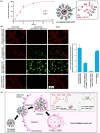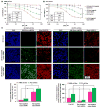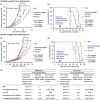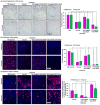Folate-targeted pH-responsive calcium zoledronate nanoscale metal-organic frameworks: Turning a bone antiresorptive agent into an anticancer therapeutic
- PMID: 26763733
- PMCID: PMC4728024
- DOI: 10.1016/j.biomaterials.2015.12.018
Folate-targeted pH-responsive calcium zoledronate nanoscale metal-organic frameworks: Turning a bone antiresorptive agent into an anticancer therapeutic
Abstract
Zoledronate (Zol) is a third-generation bisphosphonate that is widely used as an anti-resorptive agent for the treatment of cancer bone metastasis. While there is preclinical data indicating that bisphosphonates such as Zol have direct cytotoxic effects on cancer cells, such effect has not been firmly established in the clinical setting. This is likely due to the rapid absorption of bisphosphonates by the skeleton after intravenous (i.v.) administration. Herein, we report the reformulation of Zol using nanotechnology and evaluation of this novel nanoscale metal-organic frameworks (nMOFs) formulation of Zol as an anticancer agent. The nMOF formulation is comprised of a calcium zoledronate (CaZol) core and a polyethylene glycol (PEG) surface. To preferentially deliver CaZol nMOFs to tumors as well as facilitate cellular uptake of Zol, we incorporated folate (Fol)-targeted ligands on the nMOFs. The folate receptor (FR) is known to be overexpressed in several tumor types, including head-and-neck, prostate, and non-small cell lung cancers. We demonstrated that these targeted CaZol nMOFs possess excellent chemical and colloidal stability in physiological conditions. The release of encapsulated Zol from the nMOFs occurs in the mid-endosomes during nMOF endocytosis. In vitro toxicity studies demonstrated that Fol-targeted CaZol nMOFs are more efficient than small molecule Zol in inhibiting cell proliferation and inducing apoptosis in FR-overexpressing H460 non-small cell lung and PC3 prostate cancer cells. Our findings were further validated in vivo using mouse xenograft models of H460 and PC3. We demonstrated that Fol-targeted CaZol nMOFs are effective anticancer agents and increase the direct antitumor activity of Zol by 80-85% in vivo through inhibition of tumor neovasculature, and inhibiting cell proliferation and inducing apoptosis.
Keywords: Cancer; Chemotherapy; Drug delivery; Folate-targeted nanoscale metal-organic frameworks; Zoledronate.
Copyright © 2015 Elsevier Ltd. All rights reserved.
Figures








Similar articles
-
Liposome encapsulation of zoledronic acid results in major changes in tissue distribution and increase in toxicity.J Control Release. 2013 May 10;167(3):265-75. doi: 10.1016/j.jconrel.2013.02.003. Epub 2013 Feb 16. J Control Release. 2013. PMID: 23419948
-
Nanoparticles for the delivery of zoledronic acid to prostate cancer cells: a comparative analysis through time lapse video-microscopy technique.Cancer Biol Ther. 2014;15(11):1524-32. doi: 10.4161/15384047.2014.955989. Cancer Biol Ther. 2014. PMID: 25482949 Free PMC article.
-
Evaluation of antitumor effect of zoledronic acid entrapped in folate-linked liposome for targeting to tumor-associated macrophages.J Liposome Res. 2015;25(2):131-40. doi: 10.3109/08982104.2014.954128. Epub 2014 Sep 9. J Liposome Res. 2015. PMID: 25203609
-
Zoledronic acid - a multiplicity of anti-cancer action.Curr Med Chem. 2007;14(20):2126-35. doi: 10.2174/092986707781389600. Curr Med Chem. 2007. PMID: 17691952 Review.
-
Nanoscale metal-organic frameworks for biomedical imaging and drug delivery.Acc Chem Res. 2011 Oct 18;44(10):957-68. doi: 10.1021/ar200028a. Epub 2011 Jun 7. Acc Chem Res. 2011. PMID: 21648429 Free PMC article. Review.
Cited by
-
Bone targeted nano-drug and nano-delivery.Bone Res. 2024 Sep 4;12(1):51. doi: 10.1038/s41413-024-00356-2. Bone Res. 2024. PMID: 39231955 Free PMC article. Review.
-
Zoledronic Acid-Loaded Hybrid Hyaluronic Acid/Polyethylene Glycol/Nano-Hydroxyapatite Nanoparticle: Novel Fabrication and Safety Verification.Front Bioeng Biotechnol. 2021 Feb 15;9:629928. doi: 10.3389/fbioe.2021.629928. eCollection 2021. Front Bioeng Biotechnol. 2021. PMID: 33659241 Free PMC article.
-
Reverse Microemulsion-Based Synthesis of (Bis)phosphonate-Metal Materials with Controllable Physical Properties: An Example Using Zoledronic Acid-Calcium Complexes.ACS Appl Mater Interfaces. 2017 Apr 26;9(16):14478-14489. doi: 10.1021/acsami.6b15006. Epub 2017 Apr 13. ACS Appl Mater Interfaces. 2017. PMID: 28252282 Free PMC article.
-
Cationic Hydroxyethyl Cellulose Nanocomplexes and RANK siRNA/Zoledronate Co-Delivery Systems for Osteoclast Inhibition.Pharmaceutics. 2024 Dec 22;16(12):1623. doi: 10.3390/pharmaceutics16121623. Pharmaceutics. 2024. PMID: 39771601 Free PMC article.
-
Current and Future Theranostic Applications of the Lipid-Calcium-Phosphate Nanoparticle Platform.Theranostics. 2016 Apr 27;6(7):918-29. doi: 10.7150/thno.14689. eCollection 2016. Theranostics. 2016. PMID: 27217828 Free PMC article. Review.
References
-
- Green JR. Bisphosphonates: preclinical review. Oncologist. 2004;9 Suppl 4:3–13. - PubMed
-
- Berenson JR, Rosen LS, Howell A, Porter L, Coleman RE, Morley W, et al. Zoledronic acid reduces skeletal-related events in patients with osteolytic metastases. Cancer. 2001;91:1191–200. - PubMed
-
- McKeage K, Plosker GL. Zoledronic acid: a pharmacoeconomic review of its use in the management of bone metastases. Pharmacoeconomics. 2008;26:251–68. - PubMed
Publication types
MeSH terms
Substances
Grants and funding
LinkOut - more resources
Full Text Sources
Other Literature Sources
Medical

